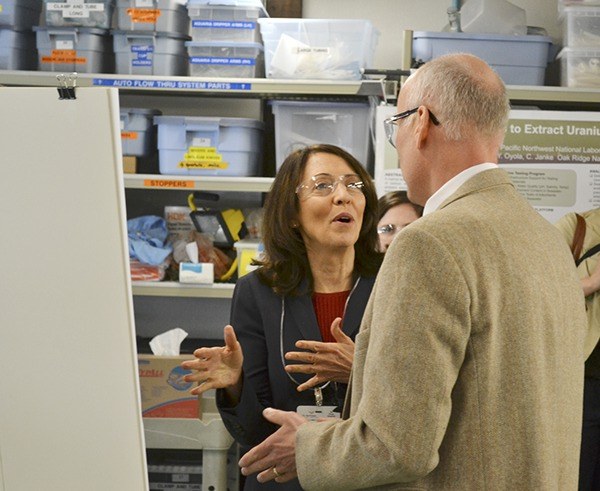Following a stop in Port Angeles to witness a carbon fiber recycling pact on July 1, U.S. Senator Maria Cantwell stopped in Sequim for a crash course on local research.
She visited the Pacific Northwest National Laboratory for the first time to see its research firsthand including scientists’ work to extract uranium from seawater and researching impacts of oil spills in arctic conditions.
“As part of our national laboratory system, there is some very, very important scientific work is being done here,” she said about her reason in visiting. “Important scientific questions are being answered whether it comes to algae or biofuels. It’s game-changing science.”
Cantwell told the Gazette two issues stand out to her that the lab could be instrumental in — oil traffic through the waters and researching Tar Sands oil.
“We as the United States just can’t leave it up to these other countries,” she said. “We need some clear answers about the impacts.”
Cantwell said the Senate is not currently investigating Tar Sands oil, which are mined for bitumen and refined into oil, “but to me seems like something we should be working on.”
“We’ve questioned the Coast Guard under the commerce committee I serve on,” she said. “They said we didn’t think we had any solutions.”
In conversation with Charles Brandt, director of the laboratory, she asked if the lab was working on it.
“Until someone identifies that as a coastal environmental issue that’s not what we’re going to do,” Brandt said — not until a national agency asks them to do so.
“(The oil) just sinks,” she said.
“As Canadians continue to pursue this, it’s the real threat to the Strait and San Juans. We’re trying to understand who is going to deliver on what to do here. If there’s no science or home remedy then the US needs to get more specific about the threat to us.”
Brandt said he couldn’t disagree and that they follow where federal agencies put money for research.
“If there was money on the table you’d be doing it?” Cantwell asked.
“We are the laboratory with the capabilities and facilities to do that,” Brandt said.
Earlier, Brandt said the lab is within three miles of the largest commercial vessel traffic corridor on the Eastern Pacific Ocean outside of the Panama Canal.
Tour
Cantwell’s tour was quick as she went from research project to project across the large campus.
Dr. Michael Huesemann spoke about their methodology for extracting biofuels from algae in two different labs.
Brandt said their objective is not to see how much biofuels they can make but to eliminate the algae from competing for food and land resources with humans.
Gary Gill, deputy director of the laboratory, shared with Cantwell how they are using a highly adsorbent material to extract uranium and other Earth minerals that can be used for items like computer chips.
Gill said the uranium extracted is more sustainable and safer in tiny amounts.
Cantwell also met with scientists about wave simulations to see how oil behaves under ice and the impacts of tidal energy on marine life and the ecosystem.
Overall, Brandt felt the tour went well.
“She was clearly impressed with what we do,” he said.
Brandt added that she was also impressed with their connection with the local economy, purchasing most of their equipment and necessities locally and/or from the region.
Pacific Northwest National Laboratory’s Marine Sciences Laboratory staffs about 85 people at 1529 West Sequim Bay Road.
Cantwell is a ranking member of the Senate Committee on Energy and Natural Resources.
Reach Matthew Nash at mnash@sequimgazette.com.



